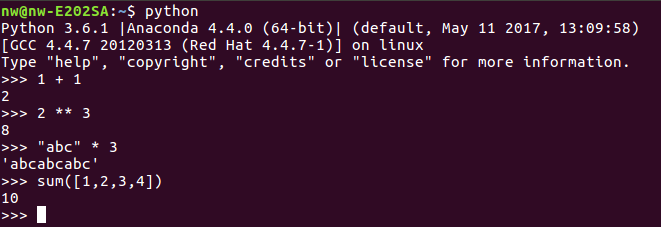3. Some Basic Grammar
3.1 Three principles
No matter which programming language you choose,
- Code runs from the first line.
- You can diverge a code by if...else.
- You can make a loop to loop.
3.2 Arithmatic
Run python from command line and execute some calculations. A part after # is ignored by Python. So I put an output.
1 + 1 # 2
2 ** 3 # 8
10 % 3 # 1
"abc" * 3 # "abcabcabc"
sum([1,2,3,4]) # 10

3.3 Type
Every variable has type. Computer handles an integer and a decimal differently. We will see what they are in the following.
type(1) # int
type(1.) # float
type("1") # str
type([1,2,3]) # list
type((1,)) # tuple
type({"a":1}) # dict
What if you add int to str?
1 + "Hi"
it throws an error.
What if you add int to float?
1 + 0.1
it works. Integer is automatically converted into float.
3.4 Loop
Try following code
for i in range(10):
print(i)
You can iterate from 0 to 9. Indentation is needed in Python. Some people prefer tab and others spaces.
How about this code?
x = ['a',9,100.1]
for i in x:
print(i)
You have just iterated in a list. "=" means substitution in programming. It does not mean "equal" in math. In this and previous examples, i is dummy. So the following code shows the same result.
for j in x:
print(j)
You can also make a condition to breaka loop
a = 0
while a < 10:
print(a)
a += 1
This is the same as the example with for i in range(10):. a += 1 means incrementation, a += 1.
3.5 if...else
Try following code. You can diverge code.
for i in range(10):
if i > 5:
print(i)
also, you can add else
for i in range(10):
if i > 5:
print(i)
else:
print(i, 'is less than six')
You can diverge as you want by adding elif clause. It comes from "else if".
for i in range(10):
if i > 5:
print(i)
elif i > 0:
print('i is positive')
else:
print('i is zero')
3.6 int and float
int is integer. float is decimal.
You can divide a number.
x = 10
y = 3
print(x / y) # gives you float 3.33333...
print(x // y) # gives int 3
print(x % y) # gives int 1
you can convert float into int
x = 2.6
y = int(x)
print(y) # 2
3.7 str
String is not a thread. It consists from characters. Either single and double quote are allowed.
s = 'Hi, human'
print(s)
You can embed variable in a string.
x = 'dog'
s = 'HI, {}'.format(x)
print(s)
You can join strings.
x = 'Hi,'
y = ' cat'
z = x + y
print(z) # 'Hi, cat'
You can contain single quote in a string quoted by double quotes and vice vaca.
x = "I've been there"
y = 'He said, "I go."'
print(x)
print(y)
When you want to use single quote in a string single quoted, escape with .
s = 'I\'ve gone'
you can slice a string.
x = 'abcde'
s = x[0:2] # 'ab'
s = x[1:3] # 'bc'
s = x[2:] # 'cde'
You can iterate a string
>>>for i in 'orange':
... print(i)
...
o
r
a
n
g
e
3.8 list
List is nice when you want to put many values.
x = 'Hi!'
a = [1,2,"a",x]
for i in a:
print(a)
To get data from a list, be careful the index starts from zero.
a = ['a', 'b', 'c']
a[0] # 'a'
a[1] # 'b'
a[2] # 'c'
a[-1] # 'c'
a[0:2] # ['a', 'b']
list.pop deletes an element from a list and returns the element.
x = a.pop() # 'c'
print(a) # ['a', 'b']
y = a.pop(0) # 'a'
print(a) # ['b']
You can add an element to an existing list.
a = []
a.append(1)
print(a) # [1]
a.append('123')
print(a) # [1, '123']
You can judge something is in a list.
2 in [1, 2, 3] # true
Also, you can get an index of an element. When an element is not found in the list, it throws an error.
x = [1,2,3]
x.index(2) # 1
x.index(0) # ValueError
Now you can calculate a sum of 1 to 100
s = 0
for i in range(101):
s = s + i
print(s)
or
s = 0
for i in range(101):
s += i
print(s)
3.9 tuple
Think tuple is length unchangeable list.
t = (1,2,3)
x = t[0]
3.10 dict
In list and tuple, order matters. In dict, order does not matter. It makes pairs of key:value.
d = {'a': 0, 'b': 1, 'c':[-1,-2]}
d['d'] = 'new key'
d[0] = 0
d['a'] # 0
3.11 function
if you want to use some code repeatedly, you can make a function.
def func(x):
return x**2
x = []
y = []
for i in range(100):
x.append(i)
y.append(func(i))
print(x)
print(y)